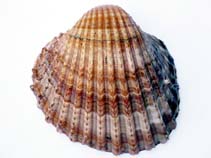| Family: |
Cardiidae (cockles) |
| Max. size: |
10.16 cm SHL (male/unsexed) |
| Environment: |
benthic; marine; depth range 5 - 30 m |
| Distribution: |
Northeast Atlantic and the Mediterranean: from Celtic and Lusitanian provinces, extending into the Mediterranean. |
| Diagnosis: |
Shell: solid, convex valves, equivalve and inequilateral, roughly oval in shape, uniformly deep yellow brown in color; sculpture consists of 20-22 well-developed ribs, with triangular spikes along the mid-line, in between are very marked concentric grooves; external ligament behind the umbones, hinge is heterodont; inside the valves are two identical scars (dimyarian and isomyarian) joined by a continuous pallial line, lacking a sinus. Body: foot is roughly cylindrical, well developed and used for leaping on the sand; distal extremity is bright red. |
| Biology: |
Minimum depth from Ref. 2703. Maximum depth from Ref. 106644. Found in an estuary (Ref. 122134). Coastal species (Ref. 112064), intertidal to the continental shelf (Ref. 105964). Lives in mud (Ref. 105964) and coarse sand (Ref. 106644). |
| IUCN Red List Status: |
Not Evaluated (N.E.) Ref. 123251)
|
| Threat to humans: |
|
| Country info: |
|
Source and more info: www.sealifebase.org. For personal, classroom, and other internal use only. Not for publication.

